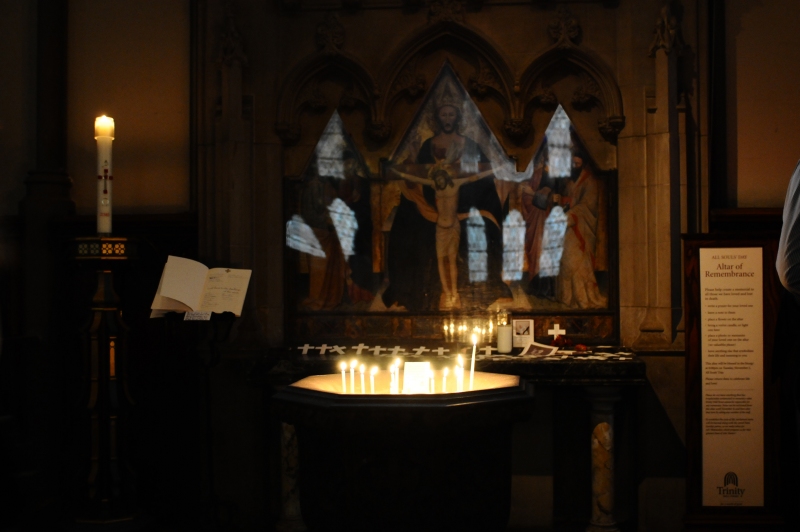October 30, 2010
Finding a Pulse Among the Dead
Halloween is a huge happening at Trinity Church.The whole downtown neighborhood of lower Manhattan is invited to one end of the churchyard for theatricality and games for kids, a costumed cocktail hour for adults at the other end, with a packed-church showing of a silent B&W classic thriller, accompanied by a full organ improv lit by candelabra.It’s an over-the-top event to be sure, though it has intention: it’s a “gateway event” that brings people to church who don’t do church.It’s meant to be a neighborly gesture: No Strings Attached.But our mission is clear, and we always offer an invitation further in.

To make that invitation more explicit this year we invited people to build together an Altar of Remembrance at the back of the church in the tradition of the Latin American Day of the Dead festivals, with a corresponding online “Virtual Altar” and Twitter feed, where anyone can upload a loved one’s photo and a message. Our intention behind this invitation is to tap into popular piety --to start where people are. People, at least the people around us in Lower Manhattan, think they’re not religious, but they’re palpably hungry. They are hungry for meaning, for integrity, and for connection. They may not think church has anything to offer them, yet everyone has someone who they love and have lost in death, who they still revere and remain close to. Giving them a physical point of connection taps into that unspoken and even unrealized connection and need, making (hallowing) a space in a death-denying culture where people can access their loss and love. We invite them to reflect on their mortality and what endures beyond death, which is deeply evangelical and theological work, and it’s immensely popular.
We’ve hit a main artery this year, as I suspected we would. The candles at the Altar of Remembrance have been all lit every hour the church is open, and the altar is starting to groan under the weight of meaning and messages left there. The online Virtual Altar and Twitter feed is growing by the hour as well. We envision our website as one of our holy spaces, along with Trinity Church and St. Paul’s Chapel, and intention is to make it a place of connection that overcomes isolation. It’s moving to see that vision coming to life, as people’s posts open the soft places of their heart to the gaze of others, who are in turn opened further to their own hearts and to the hearts of others. These slender threads, multiplied a million times as the internet so easily does, knit us together in powerful ways.
It is a modern fiction that the dead are no longer with us and we are not connected to them. Therapists make their living largely off helping us make our peace with the ancestors. Our experience tells us they surround us, if we pay attention. Scripture calls these strong influences a great “cloud of witnesses” (Hebrews 12) cheering us on and lighting the way. So really, our Day of the Dead altar, like most of the best liturgical innovations, actually recovers old and rich practices that make us more whole (thus holy).
This recovery work is crucial. So much of our secular culture and religious practice in the West has become desiccated and cerebral, with too little soul and way too much anxiety, isolation and fear. Collectively and soulfully finding our way back --and forward-- starts with individual action. Light a candle; remember and thank those who brought you here; pray for those who are coming. Someday they will be lighting a candle for you.





